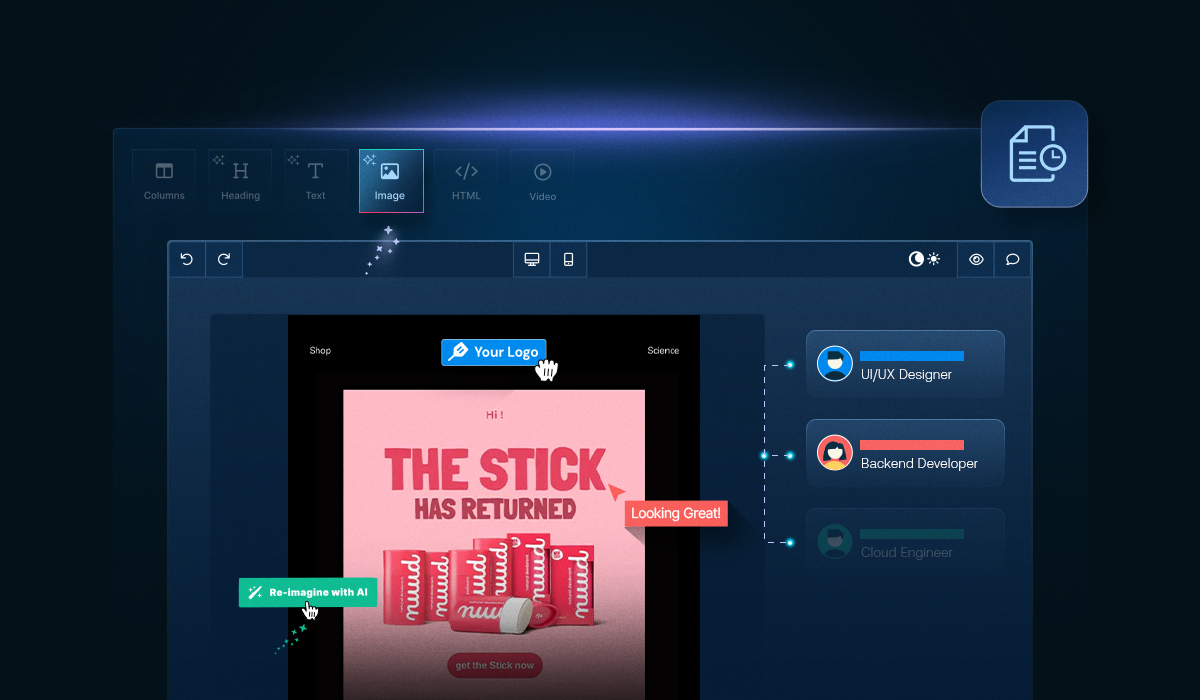Managing a CRM campaign can quickly become a complex juggling act. Multiple teams—marketing, design, and product—often work on the same email templates, landing pages, and campaign assets at the same time. A single copy change, layout adjustment, or approval delay can ripple across the workflow, causing version conflicts, lost edits, and missed deadlines.
This is where collaborative editing and version control become essential. By tracking every change, organizing approvals, and providing a clear history of edits, these features keep campaigns aligned and on schedule.
Platforms like Unlayer take it a step further, enabling teams to collaborate seamlessly on emails and landing pages, reduce errors, and launch campaigns faster and more efficiently than ever before.
In this blog, we’ll cover what collaborative editing and version control are, the challenges teams face without them, how they streamline CRM campaigns, and the tools that help teams collaborate effectively.
What Is Collaborative Editing?
Collaborative editing is the ability for multiple team members to work on the same campaign asset simultaneously, seeing changes in real-time and contributing feedback without overwriting each other’s work. In CRM campaigns, this typically applies to email templates, landing pages, and other campaign assets that require input from marketers, designers, and product managers.
Key aspects of collaborative editing include:
Role-based access controls: Clearly define who can edit, comment, or approve content, keeping responsibilities clear and workflows smooth.
Real-time updates: Everyone sees changes instantly, avoiding confusion from multiple versions.
Inline commenting and suggestions: Teams can leave feedback directly on the asset, reducing endless email chains.
Simultaneous contributions: Multiple stakeholders can edit at the same time without conflicting changes.
Collaborative editing accelerates campaign creation, reduces errors, and ensures that all contributors are aligned on branding, messaging, and layout. By integrating this into your workflow, teams can focus on producing high-quality campaigns rather than managing versions and approvals manually.
What Is Version Control?
Version control is the system that tracks every change made to a campaign asset, creating a detailed history of edits over time. In CRM campaigns, this means that every update to an email template or landing page is recorded, so teams can see who changed what and when.
Key features of version control for CRM campaigns include:
Change tracking: Every edit is logged, providing a clear record of modifications.
Rollback capability: If a mistake occurs, previous versions can be restored instantly, preventing costly errors in live campaigns.
Accountability: Teams can see exactly who made each change, making approvals and reviews transparent.
For marketing teams, version control ensures that campaigns are consistent, accurate, and easy to manage. It eliminates the risk of conflicting edits, reduces the back-and-forth of approvals, and maintains a single source of truth for every campaign asset.

Challenges CRM Teams Face Without a Unified Editing Workflow
Managing CRM campaigns without collaborative editing and version control can create far-reaching problems beyond just lost edits:
Fragmented Team Workflow: Marketing, design, and product teams often work in silos, which makes coordination harder and slows down campaign execution.
Conflicting Versions: Multiple team members working on the same email or landing page separately can overwrite each other’s changes.
Missed Feedback: Comments, suggestions, and approvals scattered across emails, chat apps, or shared drives often get overlooked, leaving important suggestions unaddressed.
Delayed Campaign Launches: Approval bottlenecks or uncertainty about the latest version can slow down timelines, pushing back campaign launches.
Inconsistent Branding: Without real-time tracking, campaign assets can diverge from your brand guidelines, potentially confusing or disengaging your audience.
Error-Prone Campaigns: Broken links, incorrect copy, or design inconsistencies are more likely to slip through without centralized collaboration.
Reduced Productivity: Teams spend more time reconciling changes than focusing on strategy, content creation, and optimization.
These challenges show that CRM campaigns aren’t just about creating emails and landing pages—they require organized collaboration, transparency, and accountability.
6 Ways Collaborative Editing & Version Control Streamline CRM Campaigns
Collaborative editing and version control do not just prevent mistakes—they actively make campaign workflows more efficient, organized, and strategic. Here’s how they help your CRM campaigns run seamlessly:

1. Complete Visibility on Campaign Progress: A centralized editing system lets the team instantly see the status of every asset. Managers can track the tasks that are completed and those that are pending, and identify potential roadblocks before they slow things down.
2. Collaboration Without the Chaos: Instead of chaotic back-and-forth across emails and chat threads, teams work within a single environment. Roles and permissions ensure edits, comments, and approvals happen smoothly without confusion.
3. Reduced Cognitive Load for Teams: When version history keeps track of every change, team members stop worrying about who did what or which file is current. This frees them to focus on meaningful work—brainstorming, designing, and strategizing.
4. Faster Iteration and Experimentation: Teams can test copy, layout, and design instantly, iterate side by side, and make changes on the fly—turning ideas into polished campaigns faster than ever.
5. Smarter, Data-Driven Decisions: By analyzing version histories and tracked edits, teams can see which changes boosted engagement or conversions—and which didn’t. These insights make it easier to plan smarter, more effective strategies for future campaigns.
6. Scalable Multi-Campaign Management: Even with multiple campaigns running at the same time, collaborative editing guarantees that quality isn’t compromised. Each campaign is tracked, organized, and aligned with your brand guidelines.
Key Takeaway: Rather than just fixing errors, collaborative editing and version control proactively streamline CRM campaigns—enhancing visibility, enabling smarter workflows, and letting teams focus on creativity and strategy.
Collaborative Editing Tools for CRM Campaigns
When it comes to CRM campaigns, most teams start with familiar tools for planning and collaboration during the early stages.
Google Docs: Allow multiple team members to edit the same document at the same time. You can leave inline comments, track changes, and access a complete version history—making it easy to see who changed what and when.
Microsoft Word/365: Offers track changes, detailed formatting options, and is familiar to most users. Version history and commenting allow for structured collaboration on documents.
Adobe Acrobat: Lets you add annotations, leave comments, and track version history for PDFs, making it easier to review and finalize documents without losing track of changes.
Note: These are collaborative document editing tools that help CRM teams draft content for any campaign and plan their workflows. They are great for collaborating on documents, but fall short when it comes to creating emails and landing pages within a CRM. Teams basically need to manually transfer content into campaign creation platforms for execution.
This is where Unlayer takes over—allowing teams to collaborate directly on emails, landing pages, and all campaign assets from the start, without first drafting in separate documents, ensuring alignment, reducing errors, and making execution effortless.
Unlayer: An all-in-one solution for collaborative CRM campaigns

Drag-and-Drop Email Builder: Quickly create newsletters, transactional emails, and automated drip campaigns tailored for CRM workflows.
Landing Page & Form Builder: Design high-converting landing pages and forms to turn visitors into valuable CRM leads.
Popup & Lead Capture Tools: Convert website visitors with behavior-triggered popups.
Team Collaboration: Multiple team members can collaborate on email templates, landing pages, and other campaign assets with comments, approvals, and role-based access.
Version Control & Rollback: Track every change, and restore previous versions with undo/redo, maintaining accuracy and campaign integrity.
CRM & SaaS Integration: Seamlessly integrates with CRM workflows and SaaS applications, keeping campaigns organized and synchronized.
Embed a powerful drag-and-drop email, landing page, and popup builder to help users create high-converting CRM campaigns—without ever leaving your platform. Get Started Now!
Conclusion
Collaborative editing and version control are no longer optional—they are essential for running efficient, error-free CRM campaigns. While tools like Google Docs, Microsoft Word, and Adobe Acrobat are great for drafting and reviewing content, Unlayer allows teams to collaborate directly on emails, landing pages, forms, and other campaign assets without switching between multiple tools.
By collaborating on CRM campaigns directly within a single embedded content creation platform, teams save time, reduce errors, and keep campaigns consistent with brand and workflow standards.
FAQs on Collaborative Editing and Version Control in CRM Campaigns
Q1: What is a Collaborative CRM?
A Collaborative CRM allows multiple team members to work together on campaign assets—such as emails, landing pages, and forms—sharing edits, comments, and feedback in real-time. It ensures everyone stays aligned, reduces errors, and streamlines approvals.
Q2: Is the team collaboration feature available on the Unlayer free or paid plan?
The team collaboration feature is a premium functionality available only on Unlayer’s paid plans. To learn more about accessing this feature or to get a plan that fits your team, check out our pricing page.
Q3: Can multiple team members edit the same campaign asset at the same time?
Yes! With real-time collaborative editing, multiple team members can edit emails, landing pages, and forms at once, with changes reflected immediately—keeping work smooth and error-free.
Q4: What are the main benefits of using collaborative editing and version control for CRM campaigns?
Using these features helps teams save time, reduce errors, maintain consistency across assets, streamline approvals, and improve overall campaign efficiency. It ensures campaigns stay on brand and can be launched faster and more confidently.
Q5: Can version history be restored if a mistake is made?
Yes. Version control allows teams to undo changes or restore previous versions, ensuring campaigns remain accurate even if an error occurs.

